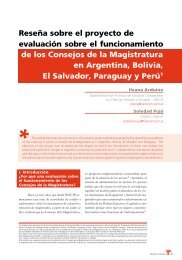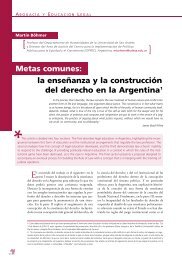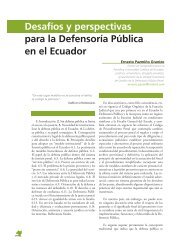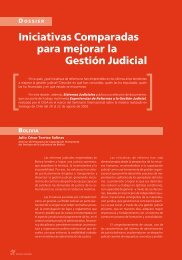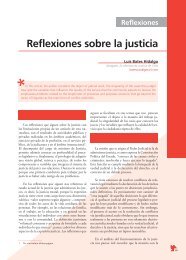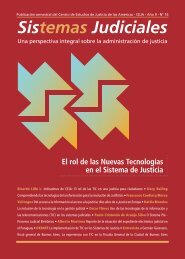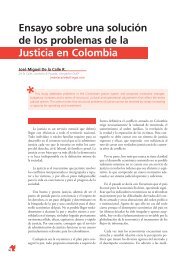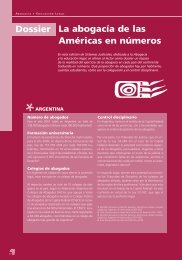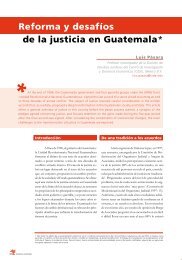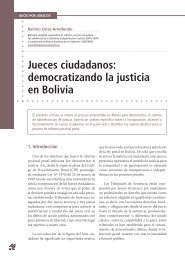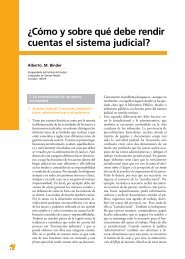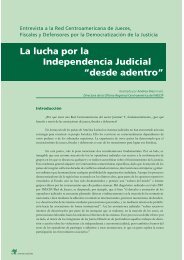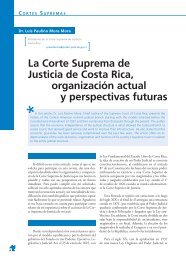Trial by Jury The Canadian experience
Trial by Jury: The Canadian experience - Revista Sistemas Judiciales
Trial by Jury: The Canadian experience - Revista Sistemas Judiciales
Create successful ePaper yourself
Turn your PDF publications into a flip-book with our unique Google optimized e-Paper software.
JUICIO POR JURADOS<br />
Katherine Corrick<br />
Judge of the Superior Court of Justice for Ontario.<br />
Marc Rosenberg<br />
Judge of the Court of Appeal for Ontario. We wish to thank<br />
Shirley Smiley, law clerk to the Court of Appeal for Ontario for<br />
her assistance with some of the research for this article.<br />
<strong>Trial</strong> <strong>by</strong> <strong>Jury</strong>:<br />
<strong>The</strong> <strong>Canadian</strong> <strong>experience</strong><br />
PART 1: BACKGROUND<br />
Any person charged with an offence has<br />
the right... to the benefit of trial <strong>by</strong> jury where<br />
the maximum punishment for the offence is<br />
imprisonment for five years or a more severe<br />
punishment.<br />
<strong>The</strong> right to be tried <strong>by</strong> a jury, enshrined<br />
in section 11(f) of the <strong>Canadian</strong> Charter of<br />
Rights and Freedoms set out above, has been<br />
a cornerstone of the criminal justice system in<br />
Canada since Canada became a country.<br />
<strong>The</strong> present-day jury system evolved over<br />
centuries as part of the English common law.<br />
Early trials <strong>by</strong> jury in England developed to assist<br />
courts to determine the facts of a case. Juries<br />
were made up of local residents summoned<br />
<strong>by</strong> Crown officials to provide sworn information<br />
about crimes that had been committed<br />
and the people suspected of committing them.<br />
Over time, English judges became reluctant to<br />
take on the responsibility of weighing the facts<br />
as found <strong>by</strong> the jury and passing judgment.<br />
Consequently, the jury’s role was extended<br />
from simply determining the facts of the case<br />
to making the final decision about the guilt or<br />
innocence of the accused person. When the<br />
right to trial <strong>by</strong> jury in criminal cases was first<br />
incorporated into <strong>Canadian</strong> law, this important<br />
role of the jury to determine guilt or innocence<br />
was already well established. 1<br />
In stark contrast to the historic jury system,<br />
however, jurors in today’s system do not<br />
know anything about the case before they begin<br />
the trial, other than what they may have<br />
read in the media. Great pains are taken to<br />
screen potential jurors to ensure that they<br />
have no relationship with the accused person<br />
and no special knowledge about the case.<br />
What kind of cases do juries hear?<br />
In Canada, jury trials are held primarily<br />
in criminal cases. Although a jury can hear a<br />
civil case, only about 15 percent of all jury trials<br />
in Canada occur in civil cases. 2 That said,<br />
the overwhelming number of trials, criminal<br />
1 For a full discussion of the history of jury trials, see<br />
Christopher Granger, <strong>The</strong> Criminal <strong>Jury</strong> <strong>Trial</strong> in Canada,<br />
2d ed. (Toronto: Carswell, 1996).<br />
2 Canada’s System of Justice: <strong>The</strong> Role of the Public, online:<br />
Department of Justice .<br />
6
Katherine Corrick / Marc Rosenberg<br />
and civil, are tried <strong>by</strong> judges without juries.<br />
This paper deals only with jury trials held in<br />
criminal cases.<br />
<strong>Trial</strong> <strong>by</strong> jury is a benefit available to a person<br />
accused of committing an indictable offence<br />
that is punishable <strong>by</strong> five years or more in prison.<br />
Indictable offences in Canada are generally<br />
more serious offences. This means that trial <strong>by</strong><br />
jury is not imposed upon an accused person.<br />
Rather, a person accused of certain offences<br />
may choose to be tried <strong>by</strong> a jury, but is not required<br />
to do so. An accused person charged<br />
with an indictable offence can choose to be<br />
tried <strong>by</strong> a judge alone, or <strong>by</strong> a judge and jury.<br />
For less serious indictable offences and<br />
summary conviction offences, the accused<br />
person does not have a choice; the accused<br />
is simply tried <strong>by</strong> judge alone. On the other<br />
hand, some of the most serious indictable offences,<br />
including murder and treason, are almost<br />
always tried <strong>by</strong> a judge and jury. 3<br />
How is a jury selected?<br />
<strong>The</strong> process of jury selection begins with the<br />
jury roll, a list of citizens who reside within the<br />
territorial district of the court who are eligible<br />
to perform jury duty. Every <strong>Canadian</strong> province<br />
has legislation that sets out who is eligible to be<br />
a juror, and the process for producing the jury<br />
roll. In Ontario, this legislation is the Juries Act.<br />
Jurors must be <strong>Canadian</strong> citizens, be at least 18<br />
years of age, and reside in the province where<br />
the court is located. Certain people are not eligible<br />
to be jurors because of their occupation.<br />
For example, judges and lawyers cannot serve<br />
on juries. Neither can prison guards nor police<br />
officers. Also, a person with a criminal record<br />
for an indictable offence cannot be a juror.<br />
3 Certain offences can only be tried <strong>by</strong> a superior court of<br />
criminal jurisdiction. If the prosecutor and the trial judge<br />
agree, even murder and treason can be tried <strong>by</strong> a judge alone.<br />
This is rarely done; virtually all murder cases are tried<br />
<strong>by</strong> a judge and jury.<br />
To summon people for jury duty, the sheriff,<br />
who is a court official, sends a notice <strong>by</strong><br />
ordinary mail to the people on the jury roll.<br />
Those people attend at the courthouse on<br />
a specified date. <strong>The</strong>se people form what is<br />
known as the jury panel. <strong>The</strong> prosecutor and<br />
the defence counsel are both provided with a<br />
list of the people on the jury panel. <strong>The</strong> list includes<br />
the name, place of residence and occupation<br />
of each person on the jury panel.<br />
Twelve jurors must be selected from the<br />
jury panel to hear a criminal case. During the<br />
selection process, the prosecutor and the accused<br />
have the right to “challenge” or reject<br />
any potential juror. <strong>The</strong> number of jurors they<br />
can challenge varies depending on the seriousness<br />
of the offence with which the accused<br />
person is charged. <strong>The</strong>y may be permitted to<br />
challenge as few as four potential jurors, or as<br />
many as twenty. <strong>The</strong> prosecutor and accused<br />
have an equal number of challenges. This type<br />
of challenge is known as a “peremptory challenge”<br />
because no reason has to be provided<br />
for challenging or rejecting the potential juror.<br />
Peremptory challenges are distinct from another<br />
kind of challenge that the prosecutor or<br />
defence can make to a potential juror –a challenge<br />
for cause. <strong>The</strong> prosecutor and accused<br />
can challenge an unlimited number of potential<br />
jurors for cause, but they must provide a<br />
sound reason for believing that the potential<br />
juror should be rejected. <strong>The</strong> most common<br />
challenges for cause relate to cases in which<br />
there has been extensive pre-trial publicity that<br />
may have prejudiced potential jurors against<br />
the accused, and to cases in which the accused<br />
person is from a racial minority and there is a<br />
concern that potential jurors may discriminate<br />
against the accused person for that reason.<br />
<strong>The</strong> Criminal Code sets out the procedural<br />
rules that govern challenging potential jurors<br />
for cause. Briefly, the prosecutor and accused<br />
are permitted to ask each potential juror questions<br />
to try to determine if the juror should be<br />
7
JUICIO POR JURADOS<br />
challenged. <strong>The</strong> trial judge must approve the<br />
questions before they are asked.<br />
Twelve jurors hear a criminal trial. <strong>The</strong>y<br />
are chosen from the jury panel according to<br />
the following process:<br />
• <strong>The</strong> jury panel is assembled in a courtroom<br />
along with the accused, defence counsel,<br />
the prosecutor, court staff and the trial<br />
judge.<br />
• <strong>The</strong> names of all members of the jury panel<br />
are placed in a box. <strong>The</strong> court staff draws<br />
the names of potential jurors from the box.<br />
As each name is called, the potential juror<br />
from the jury panel comes to the front of<br />
the courtroom.<br />
• If the jury panel is not being challenged<br />
for cause, the prosecutor and the accused<br />
alternate turns indicating whether they<br />
“challenge” the potential juror or are “content”<br />
with the potential juror.<br />
• If either the prosecutor or the accused<br />
“challenges” the potential juror, the juror<br />
is excused and rejoins the rest of the jury<br />
panel. That potential juror is eligible to be<br />
selected as a juror in another case.<br />
• If both the prosecutor and accused are<br />
content with the potential juror, the juror is<br />
sworn or affirmed as a member of the jury.<br />
<strong>The</strong> steps are repeated until twelve jurors<br />
have been selected.<br />
How does a jury trial proceed?<br />
Once the jury is selected, the charge is read<br />
to the accused, who is asked to plead guilty or<br />
not guilty. <strong>The</strong> trial judge will briefly instruct<br />
the jury about issues such as their duties, and<br />
the way the trial will proceed. <strong>The</strong> prosecutor<br />
makes an opening statement to the jury,<br />
and then calls witnesses to prove the charge<br />
against the accused. Once the prosecutor’s<br />
case is finished, the defence counsel may<br />
make an opening statement to the jury and<br />
call witnesses. After the evidence is finished,<br />
the prosecutor and the defence counsel make<br />
closing statements to the jury. If the accused<br />
calls evidence during the trial, the prosecutor<br />
addresses the jury last. If the accused calls no<br />
evidence during the trial, the defence counsel<br />
addresses the jury last.<br />
<strong>The</strong>re are certain features of jury trials that<br />
distinguish them from trials before a judge<br />
alone. For example, the jury must hear all of<br />
the evidence at trial, but the trial judge alone<br />
must consider questions about the admissibility<br />
of evidence. Some questions of admissibility<br />
are determined <strong>by</strong> the trial judge before<br />
the jury is selected. However, questions about<br />
admissibility may arise during the trial. This<br />
requires the jury to leave the courtroom and<br />
wait in the jury room while the trial judge determines<br />
the admissibility of the evidence. To<br />
determine the admissibility of evidence, the<br />
trial judge may hear witnesses, and will hear<br />
the arguments of the prosecutor and the accused.<br />
<strong>The</strong> jury cannot hear any of that. If the<br />
trial judge rules that the contested evidence is<br />
not admissible, the jury will never hear it. If<br />
the trial judge rules the evidence admissible,<br />
the evidence will be presented once the jury<br />
returns to the courtroom.<br />
Another distinguishing feature involves the<br />
jury charge. At the end of the trial, after all of<br />
the evidence has been heard and the prosecutor<br />
and the accused have addressed the jury, the trial<br />
judge then “charges” the jury. <strong>The</strong> jury charge<br />
consists of the judge’s instructions to the jury<br />
about the law that applies to the case being tried.<br />
<strong>Jury</strong> verdicts in criminal trials must be<br />
unanimous. All twelve jurors must agree on the<br />
verdict. Once the trial judge charges the jury,<br />
jurors deliberate until they reach agreement. If<br />
the jurors cannot agree after an extended period<br />
of deliberation, the trial judge may declare a<br />
mistrial and a new trial may be ordered. <strong>The</strong> jury’s<br />
decision-making process is secret and cannot<br />
be discussed with anyone outside of the jury<br />
room, even after the jury delivers its verdict. It<br />
is a criminal offence for anyone to disclose any<br />
information about a jury’s deliberations.<br />
8
Katherine Corrick / Marc Rosenberg<br />
During a jury trial, the prosecutor and defence<br />
counsel must be particularly alert about<br />
what they say before the jury. In opening and<br />
closing statements, they must not make statements<br />
that are not supported <strong>by</strong> the evidence<br />
or are unduly inflammatory. <strong>The</strong>y must not<br />
refer to facts that are not admitted in evidence,<br />
or express a personal opinion about the<br />
credibility of a witness. <strong>The</strong>y can only refer<br />
to the law to the extent that it is necessary to<br />
adequately explain the facts. It is for the trial<br />
judge to explain the law to the jurors.<br />
How does the jury know what law to<br />
apply?<br />
<strong>The</strong> trial judge is responsible for determining<br />
what law applies to the case and explaining<br />
it to the jury in the jury charge. <strong>The</strong> jury<br />
charge is fundamentally important to enable<br />
jurors to properly carry out their fact-finding<br />
functions and arrive at a proper verdict. Jurors<br />
must follow all of the instructions the trial<br />
judge gives them about the law. If required<br />
during their deliberations, jurors can ask the<br />
trial judge to clarify any questions they have<br />
about the law. Generally, the jurors will put<br />
their question in writing and a member of the<br />
court staff will deliver it to the trial judge. <strong>The</strong><br />
trial judge will then inform the prosecutor and<br />
the accused about the question and hear their<br />
submissions about the appropriate response.<br />
<strong>The</strong> jury will return to the courtroom and the<br />
trial judge will answer the question. <strong>The</strong> trial<br />
judge must always deal with the jury in open<br />
court in the presence of the accused person.<br />
Every jury charge is different. It will<br />
vary according to the offence the accused is<br />
charged with, the type of evidence heard at<br />
the trial, and the style of the individual trial<br />
judge. <strong>The</strong>re is no single recipe for a perfect<br />
jury charge. <strong>The</strong> trial judge may review all of<br />
the evidence for the jury, or only those pieces<br />
of evidence that relate to the law the jurors<br />
must apply. <strong>The</strong> trial judge may express an<br />
opinion on the weight jurors ought to give<br />
certain evidence as long as it is clear to jurors<br />
that the question of weight is theirs alone to<br />
decide. On the other hand, the trial judge may<br />
say nothing about the weight that should be<br />
assigned. <strong>The</strong> jury charge must make clear to<br />
the jury which party has the onus of proof and<br />
what burden of proof applies. Depending on<br />
the evidence heard during the trial, the trial<br />
judge may be required to give jurors special<br />
instructions about things such as the use they<br />
can make of expert evidence, the testimony of<br />
disreputable witnesses, or evidence that jurors<br />
mistakenly heard that they should not have.<br />
As the complexity of criminal trials has<br />
increased, so too has the complexity of jury<br />
charges. This has led to many trial judges providing<br />
jurors with written copies of their jury<br />
charges to take into the jury room with them<br />
while they deliberate.<br />
How does an appeal court review a jury<br />
verdict?<br />
It is particularly difficult to assess the reasonableness<br />
of a verdict following a jury trial.<br />
In Canada, jurors cannot tell anyone about the<br />
decision-making process they followed in the<br />
jury room. No reasons or explanations for a<br />
jury verdict are permitted. This decision-making<br />
model makes appellate review following a<br />
jury trial quite different from a trial <strong>by</strong> judge<br />
alone. In a judge alone trial, the focus of the<br />
appeal tends to be the trial judge’s reasons for<br />
decision. Appellate review of jury trials tends<br />
to focus on the trial judge’s decisions about the<br />
admissibility of evidence and the adequacy and<br />
correctness of the trial judge’s instructions to<br />
the jury in the charge. It is well accepted that<br />
a jury charge must be examined as a whole to<br />
determine if there has been any error. It ought<br />
not to be dissected piece <strong>by</strong> piece. Instead, the<br />
appellate court will consider the overall effect<br />
and general sense conveyed <strong>by</strong> the charge. Essentially,<br />
the question on an appeal is whether,<br />
in all likelihood, the jury correctly understood<br />
the law as it applied to the circumstances of<br />
9
JUICIO POR JURADOS<br />
the case. Exceptionally, the appeal court may<br />
set aside a conviction <strong>by</strong> a jury on the basis<br />
that the verdict was unreasonable. However,<br />
this is extremely rare.<br />
PART 2: EVIDENTIARY RULES<br />
SHAPED BY JURY TRIALS<br />
<strong>The</strong> involvement of juries in the criminal<br />
trial process has helped to shape many of Canada’s<br />
rules of evidence. In this part, we explore<br />
three examples that demonstrate the influence<br />
of juries on the rules of evidence. But first, it is<br />
important to understand the procedure used<br />
to determine the admissibility of evidence in a<br />
jury trial. This process is known as a voir dire.<br />
What is a voir dire?<br />
<strong>The</strong> easiest way to think of a voir dire is to<br />
imagine a mini-trial before the trial judge alone<br />
within the larger trial before the jury. <strong>The</strong> voir<br />
dire takes place in the absence of the jury. Typically,<br />
the prosecutor or defence counsel will inform<br />
the trial judge, in the absence of the jury,<br />
that there is evidence they wish to present to<br />
the jury that is objected to <strong>by</strong> the other side. In<br />
those circumstances, the trial judge must rule<br />
on the admissibility of the evidence before the<br />
jury can hear it. Often, this will take place before<br />
the jury is even selected. This is the most<br />
efficient method of proceeding. <strong>The</strong> trial judge<br />
rules on the admissibility of contested evidence<br />
before the trial begins. This allows the prosecutor<br />
and defence counsel to know whether they<br />
can mention the evidence in their opening addresses<br />
to the jury. It also makes the trial run<br />
more smoothly because there are fewer disruptions<br />
requiring the jury to be excused to the<br />
jury room. If an evidentiary issue that requires<br />
a voir dire arises in the middle of the trial, the<br />
jury must leave the courtroom.<br />
During a voir dire, the trial judge will hear<br />
evidence and the submissions of counsel and<br />
rule on admissibility. If the evidence is ruled<br />
admissible, it will be presented again in the<br />
presence of the jury. If it is ruled inadmissible,<br />
the jury will never hear it.<br />
Voir dires can be lengthy and complex or<br />
short and fairly simple. <strong>The</strong> trial judge may be<br />
able to deliver a ruling on admissibility from<br />
the bench or may require time to consider the<br />
matter. <strong>The</strong> outcome of a voir dire can determine<br />
the outcome of the trial. For example, if<br />
the prosecutor’s case depends on the accused’s<br />
confession, and the confession is ruled inadmissible,<br />
the prosecutor is not likely to continue<br />
with the trial if there is no reasonable<br />
prospect of obtaining a conviction.<br />
Three types of evidence provide excellent<br />
examples of the way in which jury trials have<br />
shaped the law of evidence – similar fact evidence,<br />
evidence of the accused’s prior convictions,<br />
and statements of the accused.<br />
Similar Fact Evidence<br />
<strong>The</strong> Supreme Court of Canada has held<br />
that evidence of an accused person’s general<br />
bad character is inherently prejudicial and<br />
presumptively inadmissible. 4 <strong>The</strong> fear is that<br />
if jurors hear this type of evidence they may<br />
convict the accused on the basis that the accused<br />
is “the type of person” who would commit<br />
the crime. <strong>The</strong>re is also a fear that jurors<br />
might give too much weight to the other examples<br />
of the accused’s misconduct and use<br />
them as proof that the accused committed the<br />
crime in question, and fail to adequately consider<br />
the other evidence in the case. <strong>The</strong> risk<br />
of a wrongful conviction greatly increases if<br />
jurors draw an inference of guilt from an accused<br />
person’s bad character.<br />
In spite of these fears, the Supreme Court<br />
of Canada has also recognized that sometimes<br />
evidence of the accused’s previous misconduct<br />
can be highly relevant to the search<br />
4 R. v. Handy, [2002] 2 S.C.R. 908.<br />
10
Katherine Corrick / Marc Rosenberg<br />
for the truth. 5 <strong>The</strong> evidence of previous misconduct<br />
must go beyond the general bad character<br />
of the accused, and demonstrate that<br />
the accused is likely to act in a specific way<br />
in particular circumstances. For example, assume<br />
an accused is charged with robbery. <strong>The</strong><br />
prosecution alleges that the accused entered<br />
a bank and gave the bank teller a note written<br />
in a child’s crayon that said, “Give me all<br />
your five and ten-dollar bills and you won’t<br />
get hurt.” Evidence that the accused robbed<br />
another bank in which he gave the teller a<br />
similar note written with a child’s crayon may<br />
be admissible to prove that the accused is the<br />
robber. <strong>The</strong> greater the similarity between the<br />
offence with which the accused is charged and<br />
the prior misconduct, the more valuable the<br />
evidence is in the search for the truth.<br />
If the prosecution wants to lead similar<br />
fact evidence, a voir dire must be conducted.<br />
<strong>The</strong> prosecutor and defence counsel will make<br />
submissions for and against the admissibility<br />
of the potentially dangerous evidence in the<br />
absence of the jury. <strong>The</strong> jury will only hear the<br />
evidence of prior misconduct if the trial judge<br />
rules that it is admissible.<br />
If the trial judge allows the jury to hear the<br />
evidence, the trial judge must also instruct the<br />
jurors about how they can and cannot use the<br />
evidence in their deliberations. <strong>The</strong> jurors may<br />
only use the evidence to decide the specific issue<br />
to which it is relevant; in our example, the<br />
identity of the accused as the robber. <strong>The</strong> prosecutor<br />
will likely have identified the issue for the<br />
trial judge at the beginning of the voir dire. <strong>The</strong><br />
jury may not use the evidence to decide that<br />
the accused is a person of bad character and for<br />
that reason alone more likely to have committed<br />
the robbery with which he is charged. <strong>The</strong><br />
trial judge may give this instruction to the jury<br />
right after the jury has heard the evidence and<br />
again at the end of the trial in the jury charge.<br />
5 See R. v. Sweitzer, [1982] 1 S.C.R. 949.<br />
Evidence of Prior Convictions of the Accused<br />
Evidence of an accused person’s prior convictions<br />
can be relevant in a trial, particularly<br />
if the accused testifies. It can also be highly<br />
prejudicial to the accused. Like similar fact<br />
evidence, the fear is that jurors might consider<br />
it more likely that the accused is guilty of<br />
the offence if they know that the accused has<br />
previously been convicted of crimes. <strong>The</strong> trial<br />
would be unfair if the jury used an accused<br />
person’s record of prior convictions to support<br />
a finding of guilt.<br />
At common law, evidence of the accused’s<br />
prior convictions is admissible to attack the<br />
accused’s credibility. This rule is codified in<br />
the Canada Evidence Act, which applies to all<br />
criminal trials. Section 12 of the Canada Evidence<br />
Act permits a witness to be questioned<br />
about whether the witness has been convicted<br />
of any offence. So, the trial judge has the discretion<br />
to permit the prosecutor to ask an accused<br />
who testifies at the trial about prior convictions.<br />
Despite these statutory provisions and the<br />
common law rule, there are circumstances in<br />
which allowing the jury to hear evidence of the<br />
accused’s prior convictions could result in an<br />
unfair trial. Like other evidence of prior misconduct,<br />
the risk is that the jury will give undue<br />
weight to the evidence of prior convictions. In<br />
other words, the risk is that the jury will not limit<br />
the use of the prior convictions to assessing the<br />
accused’s credibility, but will use the prior convictions<br />
as evidence that the accused committed<br />
the offence for which he or she is on trial. <strong>The</strong><br />
greater the similarity between the prior convictions<br />
and the charged offence, the greater the<br />
risk the evidence of prior convictions will be<br />
misused. For example, if an accused is charged<br />
with assault, and has a prior conviction for assault,<br />
the judge will often not permit the prosecutor<br />
to question the accused on that conviction,<br />
but permit questioning on other prior convictions,<br />
especially for crimes of dishonesty, which<br />
are much more relevant to credibility.<br />
11
JUICIO POR JURADOS<br />
If the trial judge permits the accused to be<br />
questioned about prior convictions, the jury<br />
must be instructed about how it may and how<br />
it may not use the evidence. Again, the trial<br />
judge may instruct the jury as soon after it<br />
hears the evidence and again at the end of the<br />
trial in the jury charge.<br />
Statements of the Accused<br />
Before a jury is permitted to hear evidence<br />
about a statement an accused person gave to a<br />
person in authority, such as a police officer, the<br />
prosecutor must satisfy the trial judge that the<br />
accused made the statement voluntarily. <strong>The</strong><br />
trial judge must determine this on a voir dire<br />
conducted in the absence of the jury. <strong>The</strong> issue<br />
on the voir dire is whether the accused made<br />
the statement voluntarily. This issue is never<br />
considered <strong>by</strong> the jury – it is an issue for the<br />
trial judge alone. If the statement is admitted,<br />
the jury will consider whether it is reliable evidence<br />
or not. Voluntariness as an issue is not<br />
decided <strong>by</strong> the jury.<br />
<strong>The</strong> accused is permitted to testify on a<br />
voir dire. It does not happen very often except<br />
in the case of a voir dire to determine the<br />
admissibility of a statement made <strong>by</strong> the accused.<br />
<strong>The</strong> accused is not required to testify.<br />
<strong>The</strong> accused may testify on the voir dire, and<br />
not testify at the trial.<br />
As these examples demonstrate, certain<br />
procedures have developed in the <strong>Canadian</strong><br />
law of evidence to ensure that jurors hear only<br />
admissible evidence.<br />
We now turn to the lessons learned from<br />
the <strong>Canadian</strong> <strong>experience</strong> with jury trials.<br />
PART 3: LESSONS LEARNED FROM<br />
THE CANADIAN EXPERIENCE<br />
As we have explained, in Canada, judges<br />
without juries hear the overwhelming number<br />
of civil and criminal cases. <strong>Jury</strong> trials<br />
nevertheless remain an important component<br />
of the <strong>Canadian</strong> criminal justice system. Evidentiary<br />
rules are based on the theory that a<br />
jury composed of ordinary citizens without<br />
any legal background will hear the case. <strong>The</strong> instructions<br />
to the jury in the jury charge about<br />
how to use the evidence the jurors have heard<br />
and how to apply the law are also based on the<br />
assumption that the jurors have no legal training.<br />
Yet, because in criminal cases, juries simply<br />
deliver a verdict of guilty or not guilty and do<br />
not provide reasons, it is almost impossible to<br />
determine whether the jury has followed these<br />
instructions; has properly applied the law as it<br />
has been explained; and has properly used the<br />
evidence that they have heard.<br />
Nevertheless, most trial judges believe,<br />
based on their <strong>experience</strong>, that the jury almost<br />
always delivers the correct verdict. Much of<br />
the system’s faith in the jury process is based<br />
on the view that most criminal cases turn<br />
upon findings of fact and that 12 ordinary citizens<br />
without special legal training are wellsuited<br />
to make such findings. Legal norms<br />
and rules are usually based in <strong>experience</strong> and<br />
common sense and <strong>by</strong> bringing together a<br />
group of 12 strangers with different and varied<br />
backgrounds it is possible to arrive at a factually<br />
and legally correct verdict.<br />
What are the advantages of a jury<br />
system?<br />
<strong>The</strong> jury system provides a number of important<br />
advantages. <strong>The</strong> most obvious is citizen<br />
involvement in the justice system. Most<br />
people never become involved in the criminal<br />
justice system. If they do, it is because they are<br />
victims, accused persons or witnesses. By being<br />
on a jury, the citizen has the opportunity<br />
to observe an entire trial and to gain a much<br />
better appreciation of, and value of, a properly<br />
functioning justice system. <strong>The</strong> <strong>experience</strong> of<br />
almost everyone who has served on a jury is<br />
that while they were initially somewhat reluctant<br />
to become involved because of the time<br />
12
Katherine Corrick / Marc Rosenberg<br />
commitment, in the end they found the <strong>experience</strong><br />
to be very worthwhile.<br />
Secondly, the jury system contributes to<br />
the openness and transparency of criminal<br />
proceedings. Except when they are excluded<br />
so that the judge can make evidentiary rulings,<br />
the jurors are present throughout the trial and<br />
observe the system in action. <strong>The</strong>ir mere presence<br />
guards against secrecy and censorship of<br />
criminal proceedings.<br />
Thirdly, on very rare occasions, the jury<br />
system serves as a safeguard against irrational<br />
and inhumane laws. As we have said, judges<br />
are convinced that almost always juries correctly<br />
apply the law as it has been explained<br />
to them and come to a correct verdict on the<br />
facts. <strong>The</strong>re have been occasions, however, in<br />
most common law countries that have a jury<br />
system where the jury has refused to apply the<br />
law when it was considered unfair or inhumane.<br />
<strong>The</strong> most striking examples in Canada<br />
occurred over 35 years ago when doctors were<br />
prosecuted for performing therapeutic abortions<br />
in violation of the law against abortion.<br />
Juries consistently refused to convict the doctors<br />
despite the overwhelming evidence that<br />
the offences were committed. <strong>The</strong> law was<br />
viewed as inhumane and irrational, and juries<br />
refused to apply it. In the end, after the <strong>Canadian</strong><br />
Charter of Rights and Freedoms came<br />
into force in 1982, the Supreme Court of Canada<br />
struck down the abortion laws because<br />
they violated the rights of women. While<br />
so-called jury nullification is rare, it is an important<br />
safeguard and, if nothing else, acts to<br />
deter prosecutors from seeking to enforce legislation<br />
that is out-dated and inhumane.<br />
How does the jury system deal with the<br />
open court principle?<br />
It is a fundamental principle of the <strong>Canadian</strong><br />
criminal justice system that the courts are<br />
open to the public, and the media are free to<br />
publish reports of what occurs in court. While<br />
judges trust juries to arrive at the correct verdict,<br />
there are several safeguards in place to<br />
protect against decision-making based on irrelevant<br />
or inflammatory information. We<br />
have already discussed the fact that voir dires<br />
are conducted in the jury’s absence so that if<br />
the judge rules that the evidence is inadmissible,<br />
it never comes to the jury’s attention. <strong>Canadian</strong><br />
courts, however, are open to the public,<br />
including members of the media. Conducting<br />
the voir dire in the jury’s absence would<br />
be of little value if the media could report the<br />
proceedings. Accordingly, the Criminal Code<br />
prohibits publication of anything that occurs<br />
in the absence of the jury until the trial is over.<br />
This ban on publication extends to other pretrial<br />
proceedings such as evidence heard on a<br />
bail hearing, at the preliminary inquiry 6 and<br />
in pre-trial motions before the jury is selected.<br />
<strong>The</strong> important value of the open-court<br />
principle is not, however, compromised <strong>by</strong><br />
these publication bans. Although the jury is<br />
excluded during the voir dire, the court remains<br />
open to everyone else. Once the trial<br />
is finished, the media can report on all of the<br />
pre-trial proceedings and proceedings that<br />
took place in the absence of the jury.<br />
What are the problems with appellate<br />
review of jury verdicts?<br />
We have mentioned that appellate review of<br />
jury verdicts is generally limited to a review of<br />
the trial judge’s rulings on admissibility of evidence<br />
and instructions to the jury. <strong>The</strong> limits<br />
on appellate review derive from the fact that,<br />
in Canada, as in most common law jurisdictions,<br />
juries do not provide reasons for their<br />
verdicts in criminal cases. It is therefore impossible<br />
to review the path that the jury took<br />
6 A preliminary inquiry is a hearing before a judge in which the<br />
prosecution calls witnesses to establish that there is sufficient<br />
evidence to justify the accused being put on trial. <strong>The</strong> accused<br />
or the accused’s counsel has the opportunity to cross-examine<br />
witnesses and to try and persuade the judge that the case should<br />
not proceed because of the insufficiency of the evidence.<br />
13
JUICIO POR JURADOS<br />
in finding the facts and whether it correctly<br />
applied the law to the facts. It is impossible to<br />
tell whether the jury overlooked important evidence<br />
or misunderstood important evidence.<br />
This can be a troubling aspect of jury proceedings<br />
and has led to several developments.<br />
<strong>The</strong> first is an increasingly robust role for the<br />
trial judge in screening evidence that has the potential<br />
to be misleading and unreliable. This has<br />
become known as the gatekeeper function and<br />
has assumed special importance in the area of<br />
expert evidence. <strong>The</strong> unfortunate <strong>experience</strong> in<br />
Canada over the last 20 years in which unreliable<br />
expert evidence was admitted in both jury<br />
and non-jury cases has led the Supreme Court<br />
of Canada to require judges to more carefully<br />
scrutinize expert evidence. <strong>The</strong> Court has come<br />
to appreciate that expert scientific evidence that<br />
is not properly explained, that may be unreliable,<br />
and that does not adhere to strict scientific<br />
principles may overwhelm and confuse the jury.<br />
Judges are now expected to be much more rigorous<br />
in examining the reliability of proposed<br />
expert evidence. This gatekeeper function is not<br />
confined to expert evidence. <strong>The</strong> judge is also<br />
required to critically examine other evidence<br />
that may be of limited value in reaching an accurate<br />
verdict. An example is demeanour. Until<br />
relatively recently, it was not unusual for the<br />
prosecution to lead evidence of the reaction of<br />
the accused to events in an attempt to bolster<br />
its case. For example, evidence would be led at<br />
the trial in a case involving the death of a child,<br />
where the parent was suspected of the killing,<br />
that the parent did not act “appropriately,” or was<br />
not sufficiently concerned about the child’s welfare.<br />
Experience has shown that this type of evidence<br />
is so subjective, so highly unreliable and<br />
of such limited real value that it should not be<br />
led before the jury. <strong>The</strong> judge, in carrying out the<br />
gatekeeper function, will exclude this evidence<br />
from the jury.<br />
<strong>The</strong> second development has been touched<br />
on earlier. Judges are expected to bring to the<br />
jury charge the lessons learned over the last<br />
almost 50 years from inquiries into wrongful<br />
convictions. Judges must instruct the jury, for<br />
example, on the particular dangers associated<br />
with eye-witness identification, evidence from<br />
jail-house informers, or other persons with special<br />
interests in the prosecution. Based on the<br />
wealth of <strong>experience</strong> gained from these inquiries,<br />
judges will explain to the jury the dangers of<br />
relying upon certain kinds of evidence and why<br />
this evidence may be unreliable or dangerous<br />
and why it must be subjected to special scrutiny.<br />
<strong>The</strong> third development is the increasing role<br />
appellate courts are playing in reviewing the<br />
facts in a jury case. Although juries do not give<br />
reasons, the appellate court still has the power<br />
to overturn a conviction because it is satisfied<br />
that the verdict is unreasonable. <strong>The</strong> test for<br />
overturning a jury verdict is necessarily a strict<br />
one. <strong>The</strong> values of transparency, citizen involvement<br />
and openness would be undermined<br />
if the appellate courts too frequently intervened<br />
to overturn jury verdicts simply because they<br />
did not like the result. Nevertheless, the appeal<br />
court will examine the transcript of the proceedings<br />
to determine whether the verdict is<br />
unreasonable. <strong>The</strong> appeal court is more likely<br />
to find the verdict is unreasonable where it is<br />
based upon evidence that in the court’s <strong>experience</strong><br />
has led to miscarriages of justice, such<br />
as eye-witness identification or problematic circumstantial<br />
evidence.<br />
What are the concerns about jury trials?<br />
No criminal justice system delivers perfect<br />
justice. In this final part of the paper we highlight<br />
problems that are particular to the <strong>Canadian</strong><br />
jury system. <strong>The</strong> first concerns the length and<br />
complexity of the system. <strong>The</strong>re is no question<br />
that jury trials take longer. This is a function of<br />
the manner in which the jury trials are conducted<br />
in Canada. Since evidentiary rulings are made<br />
in the absence of the jury, considerable time may<br />
be taken up in these proceedings. <strong>The</strong>n, if the<br />
evidence is admitted, it must be repeated before<br />
the jury. In a case where there are many rulings<br />
14
Katherine Corrick / Marc Rosenberg<br />
to be made or many objections <strong>by</strong> counsel, the<br />
proceedings can be very lengthy. Even in a relatively<br />
straight-forward case, a trial <strong>by</strong> a jury takes<br />
twice as long as the same case being tried <strong>by</strong> a<br />
judge without a jury.<br />
<strong>The</strong> second problem is with the complexity<br />
of jury instructions. As jury instructions have<br />
come under more intense scrutiny <strong>by</strong> appeal<br />
courts, trial judges have reacted <strong>by</strong> giving juries<br />
longer and more complex instructions to<br />
ensure that the jury charge conforms to the<br />
directions given <strong>by</strong> appeal courts in previous<br />
cases. <strong>The</strong> concern is that these complex and<br />
lengthy instructions are too difficult for the<br />
jury to properly apply. <strong>The</strong>re have been some<br />
efforts to simplify jury instructions and put<br />
the instructions in “plain language.” It is not<br />
clear that these efforts have been successful.<br />
It has also become a common feature of<br />
jury charges in Canada that trial judges review,<br />
at considerable length, the evidence that<br />
has been called at the trial. Some feel that this<br />
lengthy review of evidence is unnecessary given<br />
that the jury has also heard the evidence,<br />
is entitled to make notes as the evidence is<br />
presented, and is then given summaries of the<br />
important parts of the evidence in the closing<br />
arguments <strong>by</strong> counsel for the prosecution and<br />
for the accused. This review of evidence <strong>by</strong> the<br />
trial judge is probably a function of the concern<br />
that the jury may not have appreciated<br />
the important parts of the evidence or may<br />
have misunderstood it. Unfortunately, some<br />
judges simply repeat at great length the testimony<br />
without really performing the critical<br />
function of identifying the important pieces of<br />
evidence that the jury should take into consideration<br />
in applying the law.<br />
Finally, the increasing length and complexity<br />
of jury cases has led to concern about the continued<br />
viability of the jury system. Are jurors<br />
being asked to pay too high a price in lost time<br />
and wages while they serve on juries? As well,<br />
to date, cases of jury intimidation are almost<br />
non-existent in Canada. However, as Canada<br />
deals with more terrorism and organized crime<br />
cases, it may have to face problems that have<br />
occurred in other jurisdictions and have led to<br />
the abolition of jury trials in some cases. For<br />
example, in the United Kingdom, alleged IRA<br />
terrorists were not allowed jury trials because<br />
of the concern over jury intimidation. To date,<br />
there is no reason to take similar measures in<br />
Canada and such a change would face constitutional<br />
issues because of the entitlement to a<br />
jury trial in the Charter of Rights and Freedoms.<br />
However, other safeguards, some of them very<br />
costly, may have to be considered at some point<br />
to preserve the integrity of the system.<br />
PART 4: CONCLUSION<br />
More than twenty years ago, the Supreme<br />
Court of Canada described the important role<br />
of the jury this way:<br />
<strong>The</strong> jury, through its collective decision<br />
making, is an excellent fact finder; due to<br />
its representative character, it acts as the<br />
conscience of the community; the jury can<br />
act as the final bulwark against oppressive<br />
laws or their enforcement; it provides<br />
a means where<strong>by</strong> the public increases its<br />
knowledge of the criminal justice system<br />
and it increases, through the involvement<br />
of the public, societal trust in the system<br />
as a whole. 7<br />
While the number of jury trials in Canada<br />
has steadily declined, the jury remains a defining<br />
element of the <strong>Canadian</strong> criminal justice<br />
system. Despite the challenges the present<br />
system faces, with appropriate attention to<br />
evidentiary rules and other safeguards, the jury<br />
continues to serve its invaluable function in the<br />
<strong>Canadian</strong> criminal justice system. n<br />
7 R. v. Sherratt, [1991] 1 S.C.R. 509, at 523-24.<br />
15



